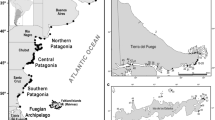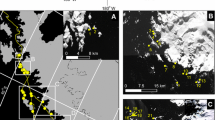Abstract
Sooty Shearwater (Puffinus griseus) is the most common Procellariiform seabird along the south-eastern South American coast. In recent years the wintering population off California has declined noticeably. This decline has been confirmed on the breeding grounds in New Zealand. In Chile, knowledge of the population is limited. Investigations on Isla Guafo were carried out during two seasons (03/04 and 04/05), beginning an ongoing monitoring and evaluation of the breeding population of this species in southern South America. On Isla Guafo we estimate a population of about 4 million birds that nest above 150 m above sea level (m.a.s.l.) under a forest without understory. Sooty Shearwaters on Isla Guafo prefer north and western slopes that we hypothesise protect them from the predominantly southerly winds. Population of the species from New Zealand and Australia are compared with the Isla Guafo population and the state of its conservation is discussed.









Similar content being viewed by others
References
Araya B, Millie G (1986) Guía de Campo de las Aves de Chile; Séptima Edición. Editorial Universitaria, Santiago de Chile
Bibby CJ, Burgess ND, David AH, Mustoe SH (2000) Bird census techniques, 2nd edn. Academic Press, London, 385 pp
Brandt CA, Parrish JK, Hodges CN (1995) Predictive approaches to habitat quantification: dark-rumped Petrels on Haleakala, Maui. Auk 112:571–579
Briggs KT, Chu EW (1986) Sooty shearwaters off California: distribution, abundance and habitat use. Condor 88:355–364
Brown RGB, Cooke F, Kinnear PK, Mills EL (1975) Summer seabird distributions in Drake Passage, the Chilean fjords and off southern America. Ibis 117:339–356
Catry P, Campos A, Segurado P, Silva M, Strange I (2003) Population census and nesting habitat selection of thin-billed prion Pachyptila belcheri on New Island, Falkland Islands. Polar Biol 26:202–207
Clark R (1986) Aves de Tierra del Fuego y Cabo de Hornos, guía de campo. L.O.L.A. Buenos Aires, Argentina, 294 pp
Clark GS, Von Meyer AP, Nelson JW, Watt JN (1984a) Notes on the Sooty shearwater and other avifauna of the Chilean offshore island of Guafo. Notornis 31:225–231
Clark GS, Goodwin AJ, Von Meyer AP (1984b) Extension of known range of some seabirds on the costal of southern Chile. Notornis 31:320–324
Cooper J, Underhill LG, Avery G (1991) Primary moult and transequatorial migration of the sooty shearwater. Condor 93:724–730
Cruz JB, Lalas C, Jillett JB, Kitson JC, Lyver POB, Imber M, Newman JE, Moller H (2001) Prey spectrum of breeding sooty shearwater (Puffinus griseus) in New Zealand. New Zeal J Mar Fresh 35:817–829
Devillers P, Terschuren JA (1978) Midsummer seabird distribution in the Chilean fjords. Le Gerfaut 68:577–588
Everett WT, Pitman RL (1993) Status and conservation of shearwater of the North Pacific. In: Vermeer K, Briggs KT, Morgan KH, Siegel-Causey D (eds) The status, ecology, and conservation of marine birds of the North Pacific. Can. Wildl. Serv. Spec. Publ., Ottawa, pp 93–100
Falla RA, Sibson RB, Turbott EG (1979) The new guide to the birds of New Zealand. New Zealand Ornithological Society, Auckland, New Zealand, 247 pp
Hamilton SA, Moller H, Robertson CJR (1997) Distribution of Sooty shearwater (Puffinus griseus) breeding colonies along the Otago Coast, New Zealand, with indication of countrywide populations trend. Notornis 44:15–25
Harrison P (1983) Seabirds – an identification guide. Croom Helm, London, Sidney
Harrison P (1987) Seabirds of the world – a photographic guide. Christopher Helm Ltd., London
Hyrenbach KD, Veit RR (2003) Ocean warming and seabird communities of the southern California Current System (1987–98): response at multiple temporal scales. Deep-Sea Res Pt II 50:2537–2565
IUCN (2006) IUCN Red List of threatened species Categories. www.redlist.net
Jehl JR (1973) The distribution of marine birds in Chilean waters in winter. Auk 90:114–135
Jones C (2000) Sooty shearwater (Puffinus griseus) breeding colonies on mainland South Island, New Zealand: evidence of decline and predictors of persistence. New Zeal J Zool 27:327–334
Lawton K, Robertson G, Kirkwood R, Valencia J, Schlatter R, Smith D (2006) An estimate of population sizes of burrowing seabirds at the Diego Ramírez archipelago, Chile, using distance sampling and burrow-scoping. Polar Biol 29(3):229–238
Lyver POB (2002) Use of traditional knowledge by Rakiura Maori to guide sooty shearwater harvests. Wildlife Soc B 30:29–40
Lyver POB, Moller H, Thompson C (1999) Changes in the sooty shearwater Puffinus griseus chick production and harvest rate precede ENSO events. Mar Ecol Prog Ser 188:237–248
Marchant S, Higgin PJ (eds) (1990) Handbook of Australian, New Zealand, and Antarctic Birds, vol 1. Oxford University Press, Melbourne, 1400 pp
Marín M (1984) Breeding record for the Sooty Shearwater (Puffinus griseus) from Chiloé Island, Chile. Auk 101:192
Moreno CA, Hucke-Gaete R, Arata J (2003) Interacción de la pesquería del bacalao de profundidad con mamíferos y aves marinas. Informe final proyecto FIP No. 2001-31. República de Chile, Ministerio de Economía, Fomento y Reconstrucción, Subsecretaría de Pesca, Fondo de Investigación Pesquera,199 pp
Murphy RC (1936) Oceanic birds of South America, vol II. The American Museum of Natural History, New York
Narosky T, Yzurieta D (2003) Aves de Argentina y Uruguay: guía para la identificación: decimoquinta edición. Vazquez Mazzini editores, Buenos Aires Argentina, 364 pp
Oedekoven CS, Ainley DG, Spear LB (2001) Variable responses of seabirds to change in marine climate: California Current, 1985–1994. Mar Ecol Prog Ser 212:265–281
Onley D, Bartle S (1999) Identificación de las aves marinas de los Océanos del Sur. Te Papa Press, Wellington New Zealand, 83 pp
Peterson RT, Chalif EL (1989) Aves de México. Editorial Diana, México, 473 pp
Reynolds PW (1935) Notes of the birds of Cape Horn. Ibis 5:65–101
Richdale LE (1954) Duration of parental attentiveness in the sooty shearwater. Ibis 96:586–600
Richdale LE (1963) Biology of Sooty shearwater Puffinus griseus. P Zool Soc Lond 141:1–117
Robbins Ch, Bruun B, Zim H (1966) Birds of North America: a guide to field identification. Goldern Press, New York
Robertson CJR, Bell BD (1984) Seabird status and conservation in the New Zealand region. In: Croxall JP, Evans PGH, Schreiber RW (eds) Status and conservation of the world’s seabirds. Inst Counc for Bird Press. Tech. Pub. No. 2, England, pp 573–586
Sagar PM, Horning DS Jr (1998) Mass-related survival of fledging Sooty Shearwaters Puffinus griseus at the Snares, New Zealand. Ibis 140:329–339
Schiavini A, Frere E, Yorio P, Parera A (1999) Las aves marinas de la Isla de los Estados, Tierra del Fuego, Argentina: revisión histórica, estado poblacional y problemas de conservación. Ans Inst Pat Punta Arenas (Chile) 27:25–40
Schlatter R (1984) The status and conservation of seabirds in Chile. In: Croxall JP, Evans PGH, Schreiber RW (eds) Status and conservation of the world’s seabirds. Inst Counc for Bird Press. Tech. Pub. No. 2, England, pp 261–269
Schlatter R (2004) Fardelas en peligro. Cartas al director Diario El Sur de Concepción, Chile 28/01/04. elsur.cl
Scholander PF (1955) Evolution of climatic adaptation in homeotherms. Evolution 9:15–26
Schramm M (1986) Burrow densities and nest site preferences of petrels (Procellarian) at the Prince Edward Islands. Polar Biol 6:63–70
Scofield P (2001) Status of sooty shearwater, Puffinus griseus, in the Wollaston and Hermite groups of southern Chile and concerns for the conservation status of Tierra del Fuego Islands. Unpublished document, 15 pp
Scofield P, Christie D (2002) Beach patrol records indicate a substantial decline in sooty shearwater (Puffinus griseus) numbers. Notornis 49:158–165
Simeone A, Bernal M, Meza J (1999) Incidental mortality of Humboldt penguins Spheniscus humboldti in gill nets, central Chile. Mar Ornithol 27:157–161
Spear LB, Ainley DG (1999) Migration routes of sooty shearwater in the Pacific Ocean. Condor 101:205–218
Uhlman S (2003) Fisheries bycatch mortalities of sooty shearwaters (Puffinus griseus) and short-tailed shearwaters (P. tenuirostris). Doc. Science Internal Series 92. Department of Conservation, Wellington, 52 pp
Valenzuela JA, Grau JH (2005) Ocurrence of American mink on the Chonos Archipelago of southern Chile. Oryx 39:15
Veit RR, Pyle P, Mcgowan A (1996) Oceanic warming and long-term change in pelagic bird abundance within the California current system. Mar Ecol Prog Ser 139:11–18
Venegas C, Sielfeld W (1979) Antecedentes para la determinación de un nuevo distrito zoo-geográfico en el litoral exterior de Magallanes. Ans Inst Pat Punta Arenas (Chile) 10:201–208
Warham J (1990) The Petrels, their ecology and breeding systems. Academic Press Limited, United States, 440 pp
Warham J (1996) The behavior, population biology and physiology of the petrels. Academic Press, New York, 611 pp
Warham J, Wilson GJ (1982) The size of the Sooty shearwater population at the Snares islands; New Zealand. Notornis 29:23–30
Warham J, Wilson GJ, Keeley BR (1982) The annual cycle of Sooty shearwater Puffinus griseus at the Snares Islands, New Zealand. Notornis 29:269–292
Watson GE, Angle JP, Harper PC, Bridge MA, Schlatter RP, Tickell WLN, Boyd JC, Boyd MM (1971) Birds of the Antarctic and Subantarctic. Antarctic Map Folio Series 14. American geographical Society, NY
Zar JH (1999) Biostatistical analysis. Prentice Hall Inc., Upper Saddle River, NJ
Acknowledgements
The authors wish to thank the Dirección de Extensión, Universidad Austral de Chile (Valdivia, Chile) and The Claremont College (Claremont CA, USA) for partially funding this study and to the Armada de Chile for the logistic support. Thanks are given to Javier Arata, Daniela Guicking, Jeffrey Mangel, Henrik Moller, Kieran Lawton, Philip Lyver, Leandro Tamini, Alejandro Simeone, Paul Scofield and Jorge Valenzuela for providing information. We would also like to thank Paul Scofield for their values comments and reviews on this manuscript. To Cesar Barrales for his help in the field. Ronnie Reyes-Arriagada Ph.D. student of the Ph.D. in Science Programme, on Systematic and Ecology, UACH, is being supported by MECESUP Higher Education Programme (UCO 0214).
Author information
Authors and Affiliations
Corresponding author
Rights and permissions
About this article
Cite this article
Reyes-Arriagada, R., Campos-Ellwanger, P., Schlatter, R.P. et al. Sooty Shearwater (Puffinus griseus) on Guafo Island: the largest seabird colony in the world?. Biodivers Conserv 16, 913–930 (2007). https://doi.org/10.1007/s10531-006-9087-9
Received:
Accepted:
Published:
Issue Date:
DOI: https://doi.org/10.1007/s10531-006-9087-9




